
Station Name: YARMOUTH SOUTH TOWN[Source:
Darren Kitson] Yarmouth South Town Gallery 4:
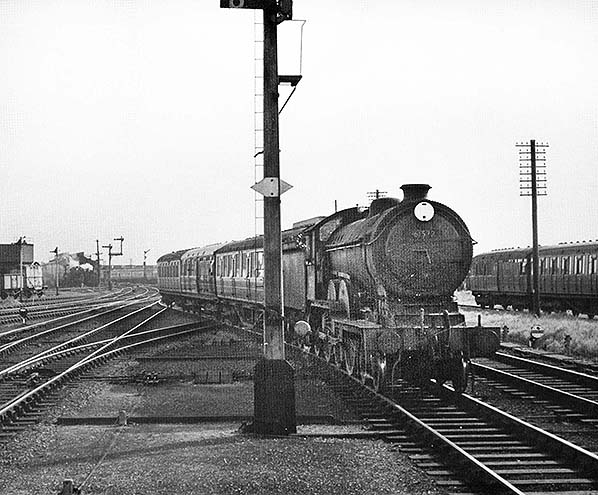
Class B12 4-6-0 No.61572 arrives at South Town in July 1958 with a short local train. In the left background, steam locomotives are on shed while the water tower can be seen at far left. The B12, or S69 under the GER, was a Holden design for the GER and in effect a stretched Claud 4-4-0. Through no real fault of their own, they became unsuitable for heavy main line work and ended up on lighter duties, often pottering around the secondary routes of East Anglia. At the time she was photographed, No.61572 was shedded at Ipswich. In her final months she was popular on railtours and also regularly worked the Yarmouth - March parcels train. Built by Beyer Peacock and new in August 1928, she was therefore technically always a B12. She became the final survivor of the class and was withdrawn in September 1961, by which time she was allocated to Norwich Thorpe. She is now preserved at the North Norfolk Railway.
Photo courtesy Rick2E from his Flickr Photostream 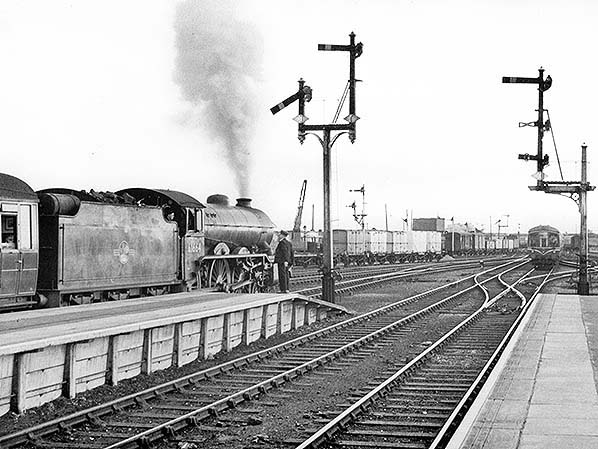 Class B17 4-6-0 No.61664 Liverpool about to depart from South Town in July 1958. She is signalled to take the Lowestoft line from Platform 1, a platform seemingly used only infrequently by passenger trains. The sidings in front of the water tower are busy with various types of goods wagon, including Conflats with insulated containers. Most of these wagons will have been shunted across from the goods yard although it appears Conflats are being dealt with on this side of the road. The crane, left of centre, appears to be a road vehicle but there was a fixed 6-ton crane at the location. On the right a Derby Lightweight DMU is approaching Platform 3. Although by no means rare at South Town, the Derby Lightweights were nevertheless not as common as the Metro-Cammell units despite being the much larger class. In the far right background a rake of hauled stock is stabled, possibly an excursion train. The vehicle nearest the camera appears, under magnification, to be of LMS origin. The signal on the right is of interest. The upper arm is the Up starter for Platform 3, the 'bow tie' arm below it controls wrong-line working over a running line and the bottom arm, with ring, controls movements into a loop or siding. Both latter signals are types of 'shunt' signal. The 'bow tie' appears to have been a design peculiar to Messrs. Stevens & Son who, it so happens, had installed the original signalling at South Town. Of the B17, as her name hints she was one of the 'Footballer' batch and was allocated to South Town at the time of the photograph. She had spent several periods at South Town, alternating with Norwich Thorpe shed. As Robert Stephenson & Hawthorns w/n 4126 she was new in January 1937 and withdrawn in June 1960 from March shed. The class became extinct two months later with the withdrawal of No.61668 Bradford City.
Photo courtesy Rick2E from his Flickr Photostream 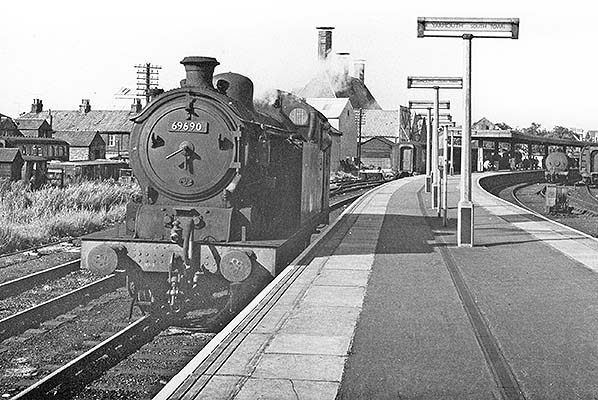
Sometime in 1958 Class N7 0-6-2T No.69690 reverses into Platform 4 at South Town while displaying, for some reason, the 'light engine' lamp position mid bufferbeam. The colour of the lamp suggests that she might be on station pilot duty but the Yarmouth South Town pilot lamp position was the right-hand side of the bufferbeam - on the left as we view this picture. Further along the platform is a rake of three or four passenger coaches, the nearest vehicle being of Gresley design. Another Gresley vehicle stands on a siding at far left, perhaps in departmental use or a cripple which has been dumped out of the way. The track to the left of the locomotive ran to the maltings, seen in the background, while another short siding branched from it and ended at the bufferstops visible right of centre. There was a further siding, out of view here, which disappeared behind the undergrowth on the left. A tank wagon stands on the locomotive release road, right, while further coaching stock sits at Platform 2. The N7 class began life as GER Class L77 but only twelve of the original 22 ordered appeared before the Grouping, the remainder of the 134-strong class appearing under LNER auspices. As built, the N7s were fitted with condensing equipment primarily for working through the Thames Tunnel but this equipment was eventually removed by the LNER. The class will be forever associated with the intensive Liverpool Street inner suburban services, the 'Jazz', and indeed Stratford always had a large number on its allocation. As well as the Liverpool Street inner suburban services, four went new to the West Riding of Yorkshire before returning south to Neasden for working services to the British Empire Exhibition at Wembley while others mingled with the N2s on the Great Northern section. The class also operated beyond the inner London area as far as, for example, Cambridge and Colchester but apart from the exceptions were rarely seen beyond. This all changed with electrification of London suburban lines, starting with the Shenfield route in 1949, and the introduction of the Thompson L1 2-6-4T. Whilst Stratford retained the bulk of the N7 class until the end, after 1949 the class began to be dispersed to country sheds well outside their traditional area of operation. Some returned to Yorkshire to deputise for the troublesome hydro-mechanical Derby Lightweight DMUs which appeared in 1954 while others ended up in Lincolnshire and Norfolk including, of all places, Melton Constable. The class also became a familiar sight at Clacton, Walton, Ipswich and Harwich. There is a degree of irony in that the GER had planned electrification of its suburban routes as early as 1902 but the scheme was abandoned due, in no small part, to the trials with the GER Class A55 locomotive better known as 'Decapod'. Holden's Decapod was to remain a one-off, being too heavy, too complex and rather too coal-hungry. The eventual outcome was the N7 class which replaced a number of 2-4-2T and 0-6-0T types. Some N7s had been fitted for Push & Pull working, No.69690 being one such. At Yarmouth the Push & Pull N7s worked the 'motor-trains' to Lowestoft and Beccles, having superceded the 2-4-2Ts. No.69690 had been one of Cambridge shed's allocation and as such was a regular on the Audley End - Bartlow line until ousted by diesel railbuses in 1958. She was transferred from Cambridge to Lowestoft in August 1958 and was still fitted with a Cambridge (31A) shedplate when photographed at South Town, suggesting the photograph was taken shortly after transfer. Her stay at Lowestoft was short and after a jostle back to Stratford, then to Parkeston Quay (Harwich) and finally back to Stratford she was withdrawn in January 1961.
Photo courtesy Rick2E from his Flickr Photostream
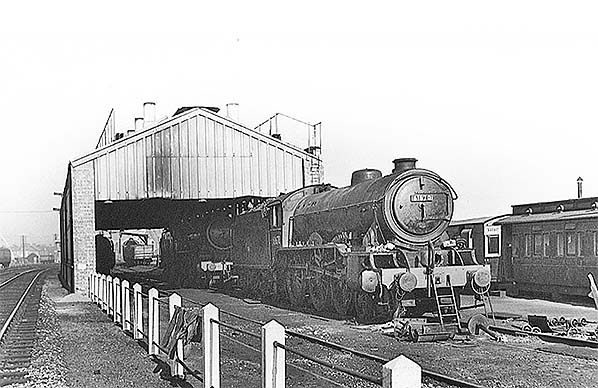
The rebuilt South Town locomotive shed seen here sometime in 1959. Precisely why the shed was fully rebuilt (in 1956) is something of a mystery; it may have been because the original with its temporary roof had become too dilapidated or it may have been a combination of this and the coming of diesel traction. In 1952 South Town already had one diesel on its books, Drewry shunter No.11001 which was later better known as D2201 of the Wisbech & Upwell Tramway. No.11101’s stay at Southtown was brief and she moved to March in August of the same year. No further diesel locomotives were based at South Town until early 1957. Diesel multiple units appeared in 1955 but none were ever based at any of the Yarmouth sheds. South Town shed closed to steam in November 1959 but continued in use for diesels until June 1962 and possibly for stabling purposes until 1964 although precisely when it was demolished is unclear. Following the end of railway use the shed apparently had a period in non-railway use but details are not known. Sitting over the pit of what was at the time her home shed is Class B17 4-6-0 No.61670 City of London. One of the B17s which fitted neither the ‘Sandringham’ nor the ‘Footballe’r banner, she was to remain at South Town until the shed closed to steam when she went to Lowestoft from where she was withdrawn five months later. Lowestoft shed, incidentally, closed on the same day as South Town shed - 30 June 1962. She is receiving attention to her inside cylinder; the drawbar has been removed as has the front guide beneath the smokebox saddle while the various piston and valve components are lying on the ground around the front of the locomotive. This picture illustrates well how minor repairs to steam locomotives could be carried out in relatively primitive conditions. Inside the shed is another locomotive, possibly another B17, while beyond the shed are two further, unidentified, locomotives of which one is in charge of a couple of open wagons, no doubt either for coal or the removal of ash. Notable by its absence is the lifting gantry seen in earlier pictures. The grounded clerestory coach on the right appears under magnification to still have at least a couple of its compartments intact or, if nothing else, the compartment divisions.
Photo from Roger Griffiths collection 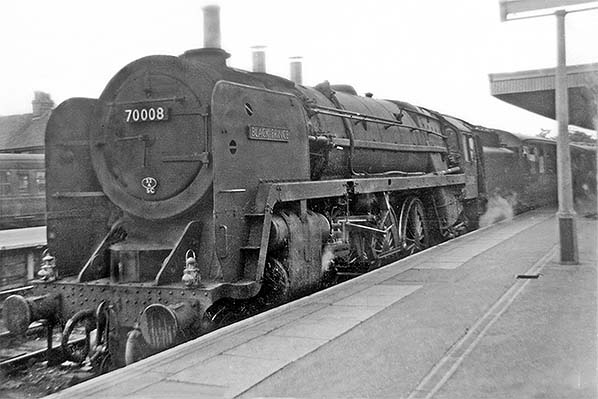
BR Britannia class 4-6-2 No.70008 Black Prince awaits departure from Platform 2 with an express for Liverpool Street. The photographer believes the photograph to have been taken during 1959, this being the final year of the line from Beccles to South Town, regular trains thereafter operating until 1962 via Lowestoft. This increased journey time but the reversal at Lowestoft, for which another locomotive would be involved, was a simpler procedure than the joining and dividing at Beccles. Introduced in 1951 the Britannias or, more correctly, the BR Standard Class 7 was a handsome design but one which was not initially without its problems. They were prone to driving wheels shifting on their axles, fractured spring hangers and a peculiar vibration which was transmitted back into the train and caused complaints from passengers. These problems dealt with, the Britannias transformed services between Liverpool Street and Norfolk, via Ipswich and Cambridge, but their reign was short as diesels began to take over in the late 1950s. No.70008 bears a 32A shedplate, Norwich Thorpe. The 'SC' beneath the shedplate indicates Self Cleaning [smokebox]; one of several innovations intended to make the job of crews easier, partly in an attempt to ease staffing and recruitment difficulties. The device comprised a heavy mesh grille, which in effect acted like a baffle, within the smokebox against which ash, drawn through from the firebox, was pulverised into smaller particles before being ejected from the chimney. It did not, however, eliminate the need for cleaning totally but merely increased the intervals at which cleaning was necessary. No.70008 was allocated to Norwich when new in April 1951. It was only possible for locomotives to run between Norwich and Yarmouth South Town, via Fleet Junction, Marsh Junction (both located at Haddiscoe) or Lowestoft, all of which involved a reversal, so the presence of No.70008 may have been via a diagram taking her, for example, from Norwich to Liverpool Street via one or other route, then to Yarmouth, then south again before eventually working back to her home shed. However, known light engine movements between Norwich and South Town were via Lowestoft, at least during British Railways days. Transferred to March shed in September 1961, from where much of her work would have been freight, No.70008 move to Kingmoor (Carlisle) in December 1963 and there she remained until withdrawal in January 1967. Two Britannias survive in preservation of which one, No.70013 ‘Oliver Cromwell’, was to see the end of steam on BR.
Photo by and reproduced by kind permission of Derek Wilson from his SmugMug website 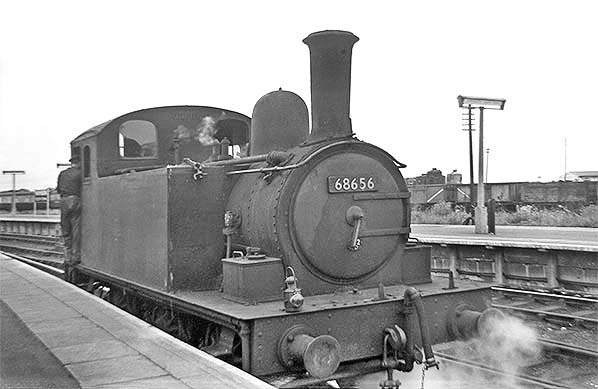 Class J68 0-6-0T No.68656 loiters at Platform 2 while on station pilot duties in July 1959. Designed by Hill, the J68 class began life in 1912 as GER Class C72 and were based upon the S56, later to become J69 class. The J68s came in two main variants, shunting or passenger, and there were a number of technical differences between the two. The first batch of passenger locomotives were put to work on the 'Jazz' services out of Liverpool Street but by early LNER days had been ousted by the N7s and thereafter became passenger pilots distributed between Stratford and East Anglian sheds. The shunting variant could be found further afield, including Lincolnshire and Nottinghamshire although Stratford retained a number. One, LNER No.7041, was sold to the Government in 1939 and saw use on various military railways ending up at Faslane. She is believed to have survived until 1946. The J68s ultimately fell victim to the massive influx of diesel shunters and smaller mainline diesels during the 1950s. Indeed, at the time No.68656 was photographed South Town shed was, and had been for a few years on and off, home to a few diesel shunters. She had been at South Town (32D) since August 1953 and was transferred to Lowestoft (32C) three months after this photograph was taken. She was withdrawn from Lowestoft in April 1960 and the class became extinct in September 1961. It is strange to think that after a working life of 46 years the diesels which ousted the likes of No.68646 did not, in many cases, even last long enough to see out the 1960s.
Photo by and reproduced by kind permission of Derek Wilson from his SmugMug website 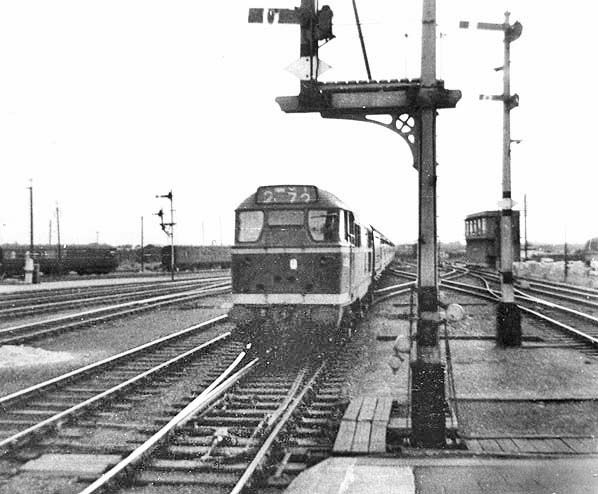
An unidentified Brush Type 2 approaches South Town's Platform 3 circa 1960. Apart from the overhead warning flash on the connecting doors (in the front of the cab) the locomotive is in its original livery. The headcode, 2 - 72, tells us that the train is a stopping service from Ipswich. This type of three-character headcode display was peculiar to the Great Eastern Section of BR. It was abolished in April 1966 in favour of the more familiar four-character system. Left of centre upper-quadrant semaphore signals can be seen but ahead of the camera antiquated wooden arm lower-quadrant signals survive. The arms with the rings control movements into a loop or sidings. The white diamond-shaped device on the dolly and on the post on the right indicated that Rule 55 did not apply. In simple terms, Rule 55 stated that a member of train crew, when stopped at a signal on a running line, was required to walk to the signal box to remind the signalman of the train's presence and sign the train register. This had to be done within three minutes in fine weather and immediately at times of fog, rain or snow. Today, changes in technology have seen the end of Rule 55 but its basic principle still applies; it is now Module S4 Section 1 of the Modular Rulebook. In the right background stands Yarmouth South Town signal box, this being the Luftwaffe-inspired 1943 rebuild. South Town's locomotive facilities stood in the left background, with the turntable being out of view behind the stabled rolling stock which includes a Gresley corridor coach and what appears to be a GUV van. Further stock is just visible in the background, to the right of the approaching train. To the left of the locomotive the tracks are Up (departure) platform road, Up bay, goods yard (leading to) and coal wharf. The track to the right of the locomotive ran into the Down bay and the track at far right led to the maltings. By the time of closure in 1970, the track into the Down bay was the sole survivor.
Photo
by Roderick G Kerry
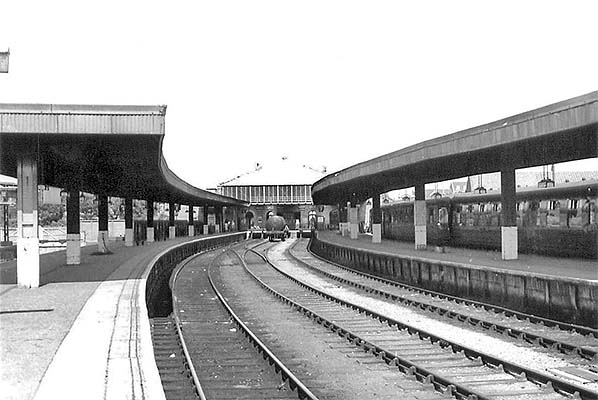
An undated view of South Town from Platform 3. The track at Platform 2 appears to see little use, suggesting that the photograph was taken after 1959. The disadvantage of Platform 2 was its lack of a locomotive release so although there are many photographs showing it in use it was probably used only when absolutely necessary. A rake of passenger stock sits at Platform 1 and comprises Gresley and BR Mk1 vehicles. The lack of passengers and the open carriage doors suggests that the stock is being cleaned internally; Platform 1 seemingly being used for a variety of purposes and also only used for service trains when absolutely necessary. Photographs from this period often show a tank wagon present but its purpose is not known.
Photo from John Mann collection 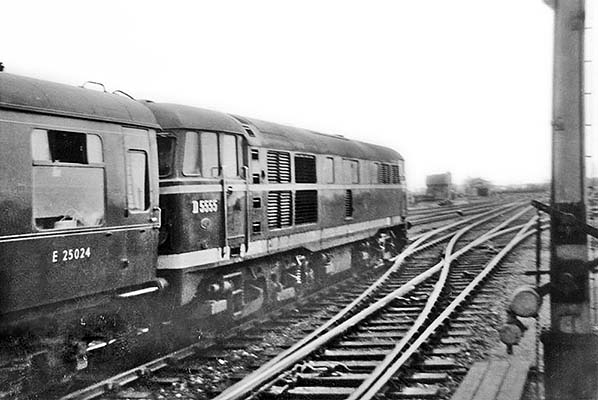
As diesels were beginning to proliferate many railway photographers snubbed them in favour of their beloved steam locomotives. Fortunately not all did and here is Brush Type 2 No.D5555 awaiting departure from Platform 2 at South Town in July 1960. By this date, of course, the train would run to Lowestoft where in all probability it would reverse and be taken forward by another locomotive either to Ipswich or through to Liverpool Street. Alternatively the train could be a summer extra or an excursion. The locomotive is out of the platform and assuming that the train is stationary, with Platform 2 able to accommodate eleven bogies it is a long train albeit not exceptionally so for the time. D5555 was one of a batch of oddities among the production examples in that it lacked roof-mounted headcode boxes and thus was externally similar to the pilot scheme batch D5500 - 19 which, incidentally, could not operate in multiple with D5520 onwards. The D5520 - D5562 batch were an erratic mix of headcode box and non-headcode box types. Several reasons for this have been put forward but the truth will probably remain a mystery. For a Type 2 locomotive the Brush Type 2 was rather heavy at around 108 tons and was unusual in having an A1A - A1A wheel arrangement, meaning each bogie had two driven axles and one unpowered axle at the centre. This wheel arrangement did give the advantage of spreading weight, thus what was to become Class 30/31 could be found on anything from main line express work to trundling along the most rickety of East Anglian branch lines. D5555, which was an Ipswich locomotive when photographed, was rebuilt from Class 30 to 31 in 1967 and went on to become No.31137. She was withdrawn in December 1995, by which time she had moved north to Thornaby. Over the years a few class members were withdrawn following accident damage, many others have been scrapped while others survive in preservation. Otherwise several others continued in main line service well into the 21st century and as of 2017 a couple are, at least on paper, still in service. Back at South Town, in the background the locomotive shed can be seen, by then closed to steam, and the water tower which could, if need be, be used to fill the train heating boiler tank on diesel locomotives - access for this is the purpose of the steps in the bodyside behind D5555's No.1 end (nearest the camera) cab. In the distance some passenger stock is stabled, although the sidings in general appear
to be remarkably uncluttered. Photo by and reproduced by kind permission of Derek Wilson from his SmugMug website 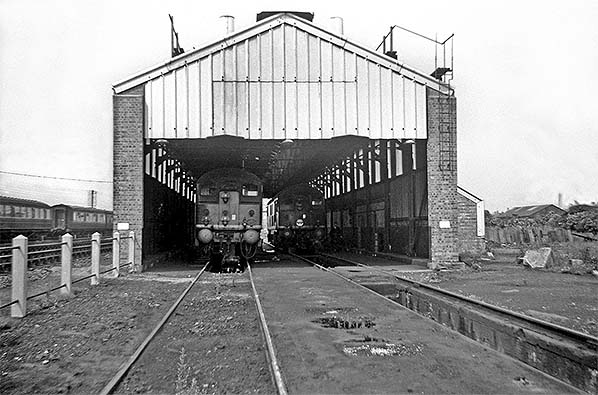 Yarmouth South Town locomotive shed sometime in, the photographer recalls, 1961 or early 1962. The camera is facing towards South Town station. The shed had been reroofed temporarily in 1952, rebuilt completely in 1956 and closed to steam on 2 November 1959, the same day as the line from Beccles closed. Thereafter main line diesels were stabled, but not allocated, while a handful of diesel shunters remained allocated. Total closure came officially on 30 June 1962 although a couple of diesel-mechanical shunters remained for a further two weeks. Inside the shed lurks a pair of BR/Sulzer Type 2's (later Class 24). At this time a number of the type were allocated to Ipswich and the pair seen here would have worked in from Lowestoft on either passenger, regular or excursion, or goods trains originating from further afield. Both locomotives are in their original green livery; what at first glance appears to be a yellow warning panel on the locomotive to the left is just the light shining on the cab front. A larger version of this image reveals both locomotives a carrying shedplates (it is just visible above the bottom centre marker light on the locomotive on the left) and both are carrying overhead warning flashes. These steam era shedplates were a common sight on diesel locomotives at one time and could also be found on some DMUs, usually on the power car but mounted on the underframe where it was not easy to see when at a platform. Like the Brush Type 2 and many other early main line diesels, Class 24 was fitted with connecting doors in the cab fronts and, again, these are also visible here. The thinking behind these was to permit a change of crew when on the move, in the fashion of corridor tenders on certain LNER steam locomotives. An adapter gangway was required to connect locomotives to coaches but the feature was rarely, if ever, used and was a source of complaints from crews owing to draughts. The connecting doors were eventually, in most cases, sealed or plated over while later builds omitted the feature entirely. Early members of Class 24 had seen service on the Southern Region on loan while until 1967 they were a common sight in East Anglia. Others went new to Gateshead. Stratford also had an allocation and others could be found on suburban services out of King's Cross. Ultimately the entire class ended up on the London Midland Region and the Scottish Region, the areas with which the class was best known. The type bowed out in 1980 but the later, improved version, Class 25, soldiered on until 1987. Examples of both have been preserved. Back at South Town shed, an ash pit survives on the right and there are further pits inside the shed. The interior of the shed is illuminated by electricity with the rather nice octagonal opaque shades of LNER origin, three of which are just visible. On the right is an office or messroom. British Railways, at least, allowed men five minutes’ walking time between station and shed. Stabled coaching stock can be seen far left with examples of Gresley, Thompson and BR MkI stock on show. Yarmouth South Town locomotive shed sometime in, the photographer recalls, 1961 or early 1962. The camera is facing towards South Town station. The shed had been reroofed temporarily in 1952, rebuilt completely in 1956 and closed to steam on 2 November 1959, the same day as the line from Beccles closed. Thereafter main line diesels were stabled, but not allocated, while a handful of diesel shunters remained allocated. Total closure came officially on 30 June 1962 although a couple of diesel-mechanical shunters remained for a further two weeks. Inside the shed lurks a pair of BR/Sulzer Type 2's (later Class 24). At this time a number of the type were allocated to Ipswich and the pair seen here would have worked in from Lowestoft on either passenger, regular or excursion, or goods trains originating from further afield. Both locomotives are in their original green livery; what at first glance appears to be a yellow warning panel on the locomotive to the left is just the light shining on the cab front. A larger version of this image reveals both locomotives a carrying shedplates (it is just visible above the bottom centre marker light on the locomotive on the left) and both are carrying overhead warning flashes. These steam era shedplates were a common sight on diesel locomotives at one time and could also be found on some DMUs, usually on the power car but mounted on the underframe where it was not easy to see when at a platform. Like the Brush Type 2 and many other early main line diesels, Class 24 was fitted with connecting doors in the cab fronts and, again, these are also visible here. The thinking behind these was to permit a change of crew when on the move, in the fashion of corridor tenders on certain LNER steam locomotives. An adapter gangway was required to connect locomotives to coaches but the feature was rarely, if ever, used and was a source of complaints from crews owing to draughts. The connecting doors were eventually, in most cases, sealed or plated over while later builds omitted the feature entirely. Early members of Class 24 had seen service on the Southern Region on loan while until 1967 they were a common sight in East Anglia. Others went new to Gateshead. Stratford also had an allocation and others could be found on suburban services out of King's Cross. Ultimately the entire class ended up on the London Midland Region and the Scottish Region, the areas with which the class was best known. The type bowed out in 1980 but the later, improved version, Class 25, soldiered on until 1987. Examples of both have been preserved. Back at South Town shed, an ash pit survives on the right and there are further pits inside the shed. The interior of the shed is illuminated by electricity with the rather nice octagonal opaque shades of LNER origin, three of which are just visible. On the right is an office or messroom. British Railways, at least, allowed men five minutes’ walking time between station and shed. Stabled coaching stock can be seen far left with examples of Gresley, Thompson and BR MkI stock on show.Photo by and reproduced by kind permission of Derek Wilson from his SmugMug website Click here for Yarmouth South Town Gallery 5:
 Home Page Home Page
|
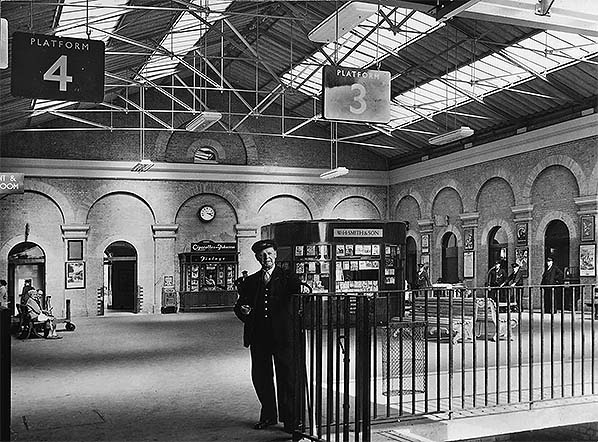 One of very few known photographs showing with any clarity South Town station concourse virtually in its entirety and when still in use. An Eastern Daily Press photograph dating from 14 July 1954, stationmaster M. E. Lawn is seen beside the barrier leading to platforms 3 and 4. Six other staff members are visible, of which five are also posing for the camera. The open door, left of centre, led through the booking hall and out onto the station forecourt. Mr. Lawn and his family's accommodation was on the first floor above the booking hall, the pitched facade, present on both faces of the building, was deceiving and much of the roof was actually flat - see photographs of the exterior. The open door at far left led into the stationmaster's clerk's office and then the stationmaster's office. A member of staff can be seen through the doorway, probably reading staff notices. The 1952 BR alterations to Yarmouth South Town are well known, although it is not immediately obvious from this view that the changes had already taken place. The original trainshed roof, removed in 1952, extended back to cover the concourse and was to a clerestory design but the rather factory-like roof seen here predated this alteration and is thought to have been erected following damage during WWII. For a larger version of the photograph and more details click
One of very few known photographs showing with any clarity South Town station concourse virtually in its entirety and when still in use. An Eastern Daily Press photograph dating from 14 July 1954, stationmaster M. E. Lawn is seen beside the barrier leading to platforms 3 and 4. Six other staff members are visible, of which five are also posing for the camera. The open door, left of centre, led through the booking hall and out onto the station forecourt. Mr. Lawn and his family's accommodation was on the first floor above the booking hall, the pitched facade, present on both faces of the building, was deceiving and much of the roof was actually flat - see photographs of the exterior. The open door at far left led into the stationmaster's clerk's office and then the stationmaster's office. A member of staff can be seen through the doorway, probably reading staff notices. The 1952 BR alterations to Yarmouth South Town are well known, although it is not immediately obvious from this view that the changes had already taken place. The original trainshed roof, removed in 1952, extended back to cover the concourse and was to a clerestory design but the rather factory-like roof seen here predated this alteration and is thought to have been erected following damage during WWII. For a larger version of the photograph and more details click 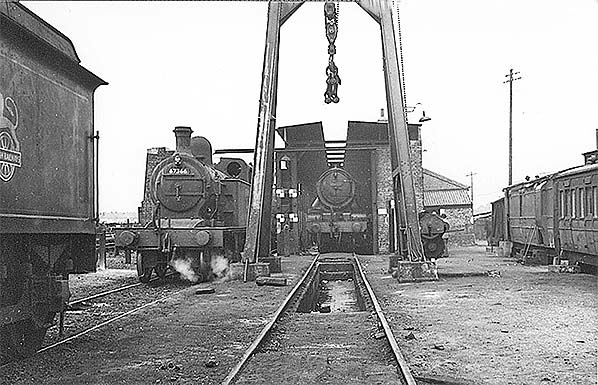 Yarmouth South Town locomotive shed, or rather what remained of it, on 26 May 1956 showing the temporary roof in place shortly before the shed was totally rebuilt. The shed was able to effect light repairs, hence the gantry directly ahead of the camera. The block and tackle, beefy as it was, was by no means capable of lifting a locomotive entirely off the rails but could lift one end in order to carry out, say, a bearing or horn replacement or perhaps drop a complete wheelset. The facility was quite common and could be found almost anywhere bar the smallest rural outstation sheds. The tender on the left bears the original British Railways logo known as the 'Cycling Lion'. It was a variation of what was then the British Transport Commission logo which could also be seen on certain buses with Eastern Coach Works bodies; for example the early version of the Bristol Lodekka LD series had it on small plate mounted on the platform. Standing next to the gantry is Class C12 4-4-2T No.67366. These had begun life as Great Northern Railway Class C2 and designed by H A Ivatt (not to be confused with his son, H G) the first batch appeared in 1898 for use in the West Riding of Yorkshire. Subsequent batches went for use on London suburban services. Initially very successful, like many other classes they soon fell victim to increases in train weights and as early as 1903 what was intended as their replacement appeared. This was the little-known Class L1 (later LNER Class R1), an unsuccessful 0-8-2T which had the appearance of a stretched version of the later N2 0-6-2T. Too heavy and apparently incapable of exceeding 40mph, the R1s ended up in Yorkshire working goods trains. Thus it was left initially to the Class N1 0-6-2T, also unsuccessful and ending up in Yorkshire, and then to the N2 class to oust most C12s from London suburban services. Thereafter Class C12 became best known for the West Riding and Lincolnshire, arguably more so the latter. The type did not abandon London and the South East entirely, however. In early BR days a few could be seen on King's Cross - Alexandra Palace duties A few more could be found at Cambridge at various times with others dotted around East Anglia. No.67366 had wandered as far as Trafford Park (Manchester) before finding her way back to East Anglia. At the time she was photographed she was a South Town resident and remained so until withdrawn in April 1958. Lurking in the shed is what appears to be, going by the position and angle of the steam pipes, a Class B17 4-6-0. Any shed worth its salt had a number of grounded bodies for use as sheds and bothies. On the right is the body of what had been a luggage brake, probably a six-wheeler, and the body of clerestory coach complete with torpedo ventilators. Beyond them stands the body of an outside-framed goods van. Clerestory coaches were quite charming vehicles and it was around the time of this photograph that the final examples were withdrawn from passenger service, excepting the ex-LT Standard tube stock which went to the Isle of Wight in 1967. The plates fixed to the shed displaying chequered red and white advise of limited clearances between fixed structures and rail vehicles. They are still in use today.
Yarmouth South Town locomotive shed, or rather what remained of it, on 26 May 1956 showing the temporary roof in place shortly before the shed was totally rebuilt. The shed was able to effect light repairs, hence the gantry directly ahead of the camera. The block and tackle, beefy as it was, was by no means capable of lifting a locomotive entirely off the rails but could lift one end in order to carry out, say, a bearing or horn replacement or perhaps drop a complete wheelset. The facility was quite common and could be found almost anywhere bar the smallest rural outstation sheds. The tender on the left bears the original British Railways logo known as the 'Cycling Lion'. It was a variation of what was then the British Transport Commission logo which could also be seen on certain buses with Eastern Coach Works bodies; for example the early version of the Bristol Lodekka LD series had it on small plate mounted on the platform. Standing next to the gantry is Class C12 4-4-2T No.67366. These had begun life as Great Northern Railway Class C2 and designed by H A Ivatt (not to be confused with his son, H G) the first batch appeared in 1898 for use in the West Riding of Yorkshire. Subsequent batches went for use on London suburban services. Initially very successful, like many other classes they soon fell victim to increases in train weights and as early as 1903 what was intended as their replacement appeared. This was the little-known Class L1 (later LNER Class R1), an unsuccessful 0-8-2T which had the appearance of a stretched version of the later N2 0-6-2T. Too heavy and apparently incapable of exceeding 40mph, the R1s ended up in Yorkshire working goods trains. Thus it was left initially to the Class N1 0-6-2T, also unsuccessful and ending up in Yorkshire, and then to the N2 class to oust most C12s from London suburban services. Thereafter Class C12 became best known for the West Riding and Lincolnshire, arguably more so the latter. The type did not abandon London and the South East entirely, however. In early BR days a few could be seen on King's Cross - Alexandra Palace duties A few more could be found at Cambridge at various times with others dotted around East Anglia. No.67366 had wandered as far as Trafford Park (Manchester) before finding her way back to East Anglia. At the time she was photographed she was a South Town resident and remained so until withdrawn in April 1958. Lurking in the shed is what appears to be, going by the position and angle of the steam pipes, a Class B17 4-6-0. Any shed worth its salt had a number of grounded bodies for use as sheds and bothies. On the right is the body of what had been a luggage brake, probably a six-wheeler, and the body of clerestory coach complete with torpedo ventilators. Beyond them stands the body of an outside-framed goods van. Clerestory coaches were quite charming vehicles and it was around the time of this photograph that the final examples were withdrawn from passenger service, excepting the ex-LT Standard tube stock which went to the Isle of Wight in 1967. The plates fixed to the shed displaying chequered red and white advise of limited clearances between fixed structures and rail vehicles. They are still in use today.